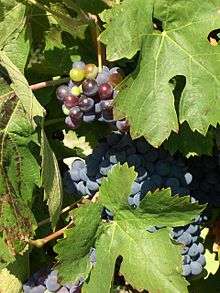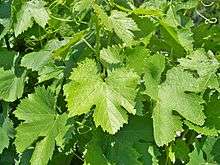Cinsaut
| Cinsaut | |
|---|---|
| Grape (Vitis) | |
 Cinsaut in Viala & Vermorel | |
| Color of berry skin | Noir |
| Species | Vitis vinifera |
| Also called | Cinsault, Cinq Sao, Ottavianello (more) |
| Origin | France |
| Notable regions | Southern France, Morocco, Algeria, Lebanon |
| Notable wines | Chateau Musar, Ostuni Ottavianello |

Cinsaut or Cinsault (/ˈsænsoʊ/ SAN-soh) is a red wine grape, whose heat tolerance and productivity make it important in Languedoc-Roussillon and the former French colonies of Algeria and Morocco. It is often blended with grapes such as Grenache and Carignan to add softness and bouquet.[1]
It has many synonyms, of which perhaps the most confusing is its sale as a table grape called 'Oeillade', although it is different from the "true" Oeillade which is no longer cultivated. In South Africa, it was known as "Hermitage", hence the name of its most famous cross Pinotage.
History
Cinsault appears to be an ancient variety that may have originated in the Hérault, but could equally have been brought by traders from the eastern Mediterranean.
Distribution and wines
Algeria
Cinsaut is popular in Algeria for its drought resistance, and is used to make large volumes of wine.
Australia
Cinsaut is grown under a variety of names such as Black Prince, Blue Imperial, Oeillade and Ulliade.
France
Cinsaut is the fourth most widely planted grape variety in France, and is especially important in Languedoc-Roussillon. It is also widely used for rosé wines in Provence.
Italy

Known as Ottavianello, there is one tiny DOC devoted to Cinsaut - Ostuni Ottavianello, with a total production of less than 1000 cases a year.[2] However, Cinsaut has long been used in Apulian blends and has also begun to attract the attention of winemakers interested in reviving old varieties.[3]
Lebanon
Cinsaut is an important component in the blend of Lebanon's Chateau Musar.
Morocco and Tunisia
As in Algeria, Cinsaut is popular in Morocco and Tunisia for its drought resistance.
South Africa
A lot of Cinsaut is grown in South Africa much of which is blended with Cabernet Sauvignon. It holds a special place in the country's viticulture alongside Pinot noir as one of the parents of Pinotage.
United States
The oldest continuous Cinsault vineyard is said to be the Bechtold vineyard in Lodi, California, which was planted in 1885 by Joseph Spenker.[4]
Some Cinsaut is planted in California as Black Malvoisie.
Cinsaut is planted in the Yakima Valley AVA in Washington.
Vine and Viticulture
The vine can produce heavy crops, but wines are much better if yields are controlled. Cinsaut is very drought resistant but can be susceptible to disease, so appreciates a dry climate. It produces large cylindrical bunches of black grapes with fairly thick skins.
Synonyms and confusion with other grapes
Black Malvoisie, Blue Imperial, Bourdales Kek, Budales, Calibre, Chainette, Cincout, Cinq-sao, Cinquien, Cinsanet, Cinsault, Cubilier, Cubillier, Cuviller, Espagne, Espagnol, Froutignan, Grappu De La Dordogne, Hermitage, Malaga Kek, Marocain, Maurange, Mavro Kara Melkii, Milhau, Morterille noire, Moustardier Noir, Navarro, Negru De Sarichioi, Oeillade noire, Ottavianello, Ottaviano, Ottavianello, Pampous, Papadou, Passerille, Pedaire, Picardan noir, Piquepoul D'Uzes, Pis De Chevre, Plant D Arles Boudales, Plant D'Arles, Plant De Broqui, Plant De Broquies, Poupe De Crabe, Pousse De Chevre Rouge, Prunaley, Prunelas, Prunella, Prunellas noir, Salerne, Samsó, Samson, Senso, Sensu, Sinsó, Strum, Takopulo Kara, Ulliaou, West's White Prolific,[5] Black Prince, Boudales, Oeillade, Picardin noir and Ulliade.
While Cinsault is known under the synonym Oeillade noire, especially when it is sold as a table grape, it is not related to the Languedoc and Provence wine grape Oeillade noire.[6]
References
- ↑ Jancis Robinson, Vines, Grapes & Wines Mitchell Beazley 1986 ISBN 1-85732-999-6
- ↑ Ministero delle Politiche Agricole Alimentari e Forestale, Banca Dati Vini DOC, DOCG :: Ostuni Ottavianello (Italian))
- ↑ Accademia dei Racemi at diwinetaste.com
- ↑ Caparoso, Randy. "Lodi's oldest existing vines: the magical Bechthold Vineyard". LoCa: The Wines of Lodi, CA. Retrieved 3/1/2014. Check date values in:
|access-date=(help) - ↑ Maul, E.; Eibach, R. (1999-06-00). "Vitis International Variety Catalogue". Information and Coordination Centre for Biological Diversity (IBV) of the Federal Agency for Agriculture and Food (BLE), Deichmanns Aue 29, 53179 Bonn, Germany. Archived from the original on 2007-04-11. Retrieved 2007-04-22. Check date values in:
|date=(help) - ↑ J. Robinson, J. Harding and J. Vouillamoz Wine Grapes - A complete guide to 1,368 vine varieties, including their origins and flavours pg 743, Allen Lane 2012 ISBN 978-1-846-14446-2